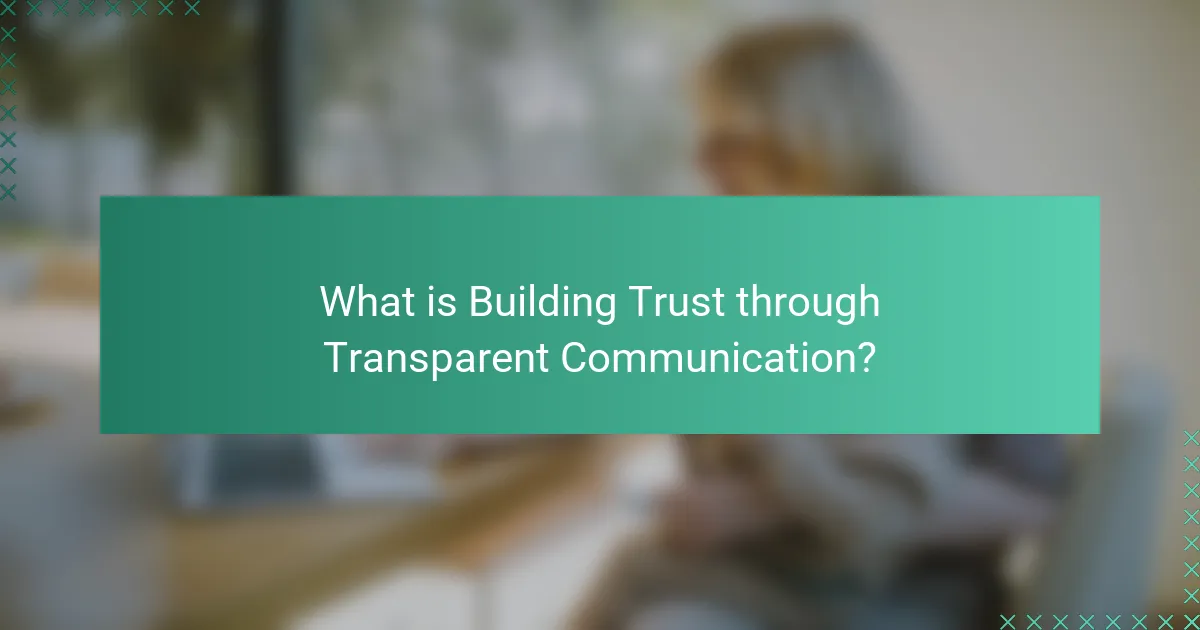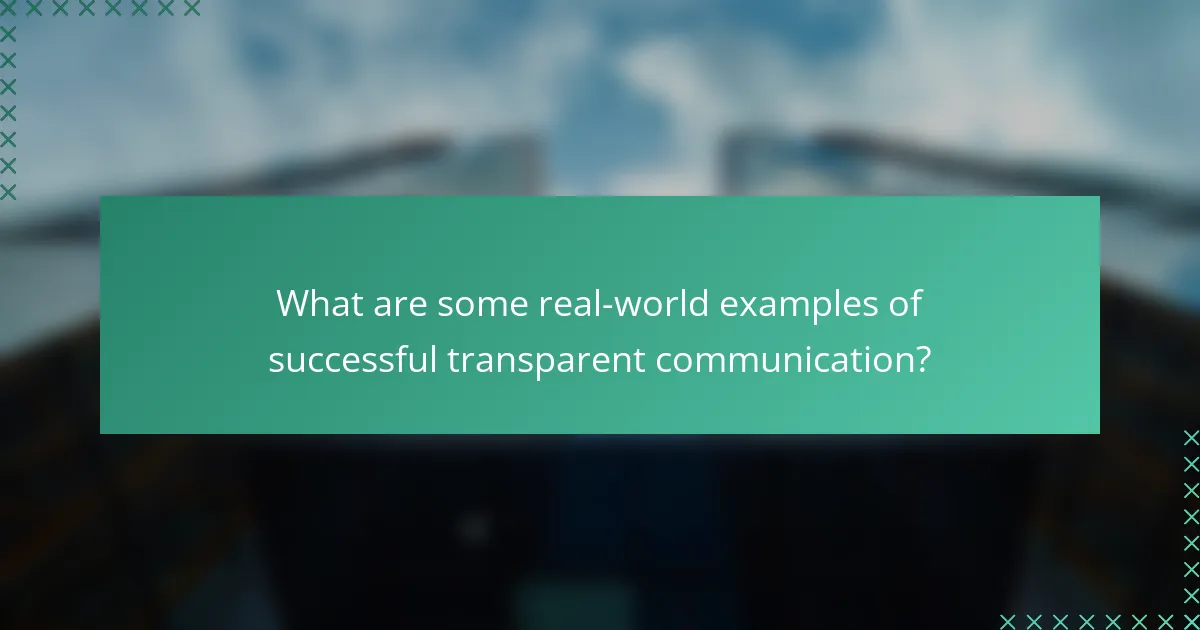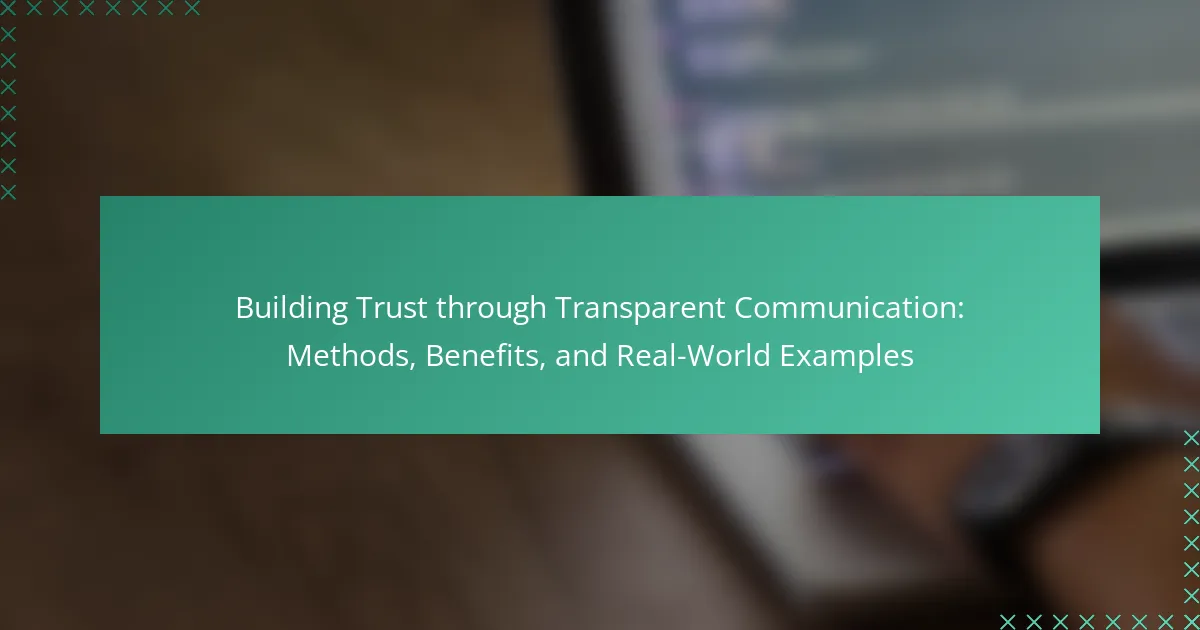Building trust through transparent communication is essential for fostering openness and honesty within organizations. This article examines methods for implementing transparent communication, including regular information sharing, active listening, and utilizing multiple communication channels. It highlights the benefits of transparency, such as increased employee engagement, enhanced collaboration, and improved organizational reputation. Real-world examples from companies like Buffer and Patagonia illustrate how transparency can build trust and credibility with stakeholders. The article emphasizes that clear communication not only reduces misunderstandings but also promotes accountability and innovation in the workplace.

What is Building Trust through Transparent Communication?
Building trust through transparent communication involves fostering openness and honesty in interactions. This approach encourages sharing information clearly and without hidden agendas. Organizations that practice transparent communication often see increased employee engagement. According to a study by the Harvard Business Review, transparency can enhance team collaboration and performance. Clear communication reduces misunderstandings and builds stronger relationships. Trust is essential for effective teamwork and organizational success. Transparency also promotes accountability, as individuals feel responsible for their contributions. Overall, building trust through transparent communication creates a positive environment that benefits all stakeholders.
How does transparent communication contribute to trust-building?
Transparent communication fosters trust by promoting openness and honesty. It allows individuals to share information freely. This clarity reduces misunderstandings and builds a foundation for reliable relationships. Trust is strengthened when parties feel informed and included. Studies show that organizations with transparent communication experience higher employee satisfaction. For instance, a report from the Institute for Public Relations states that transparency leads to increased trust in leadership. Therefore, transparent communication is essential for effective trust-building.
What are the key elements of transparent communication?
Key elements of transparent communication include clarity, honesty, openness, and consistency. Clarity ensures that messages are easily understood. Honesty involves sharing accurate information without deception. Openness fosters an environment where questions and feedback are welcomed. Consistency means delivering messages that align with actions and policies. These elements build trust and improve relationships. Research indicates that organizations with transparent communication have higher employee engagement and satisfaction.
How do these elements foster trust in relationships?
Transparent communication fosters trust in relationships by ensuring clarity and honesty. Clear communication reduces misunderstandings and aligns expectations between parties. Honesty promotes integrity, which strengthens the bond between individuals. When people share information openly, it creates a sense of security. This environment encourages vulnerability, allowing deeper connections to form. Research indicates that transparent communication leads to higher relationship satisfaction. A study by the Journal of Social and Personal Relationships found that open dialogue correlates with increased trust levels. Thus, these elements collectively reinforce trust in relationships.
Why is trust important in communication?
Trust is crucial in communication because it fosters open dialogue and understanding. When individuals trust each other, they are more likely to share their thoughts and feelings honestly. This openness leads to better collaboration and problem-solving. Trust also reduces misunderstandings and conflicts, as parties believe in the intentions of one another. Research indicates that effective communication in teams is significantly enhanced by trust, leading to improved performance outcomes. In environments where trust is established, members feel safe to express dissenting opinions, which can drive innovation. Overall, trust enhances the quality and effectiveness of communication.
What role does trust play in personal and professional relationships?
Trust is essential in personal and professional relationships. It fosters open communication and collaboration. Trust leads to stronger bonds and mutual respect. In a professional setting, trust enhances teamwork and productivity. Research shows that high trust levels correlate with improved job satisfaction. For instance, a study by the Institute for Corporate Productivity found that organizations with high trust experience 50% higher employee engagement. Trust also reduces conflict and misunderstandings. It creates a safe environment for sharing ideas and feedback. Ultimately, trust is a foundational element that influences the quality of relationships.
How can a lack of trust impact communication effectiveness?
A lack of trust significantly diminishes communication effectiveness. When trust is absent, individuals are less likely to share information openly. This leads to misunderstandings and misinterpretations. In environments lacking trust, people may withhold feedback or fail to engage in meaningful dialogue. Consequently, collaboration suffers, and team dynamics weaken. Research indicates that trust enhances information sharing, which is crucial for effective communication. A study by Dirks and Ferrin (2002) found that trust positively influences communication quality in organizations. Thus, without trust, communication becomes fragmented and less productive.

What methods can be used to build trust through transparent communication?
Clear and consistent messaging builds trust through transparent communication. Regularly sharing information fosters an open dialogue. Providing timely updates on changes or developments enhances credibility. Actively listening to feedback shows respect for others’ opinions. Encouraging questions creates a safe space for discussion. Utilizing multiple channels ensures information reaches diverse audiences. Sharing data and evidence supports claims and reinforces trustworthiness. Transparency in decision-making processes builds confidence in leadership.
What are the most effective strategies for transparent communication?
Effective strategies for transparent communication include clarity, consistency, and openness. Clarity involves using simple language to convey messages. This reduces misunderstandings and fosters comprehension. Consistency ensures that messages align over time and across different platforms. Consistent messaging builds trust and reliability. Openness encourages sharing information freely, including both successes and failures. This approach promotes a culture of honesty. Active listening is also crucial. It allows feedback and questions, enhancing engagement. Moreover, regular updates keep stakeholders informed. Transparency in decision-making processes further strengthens trust. Research shows that organizations practicing transparent communication see improved employee morale and collaboration.
How can active listening enhance transparency?
Active listening enhances transparency by ensuring clear and open communication. It involves fully concentrating on the speaker, understanding their message, and responding thoughtfully. This practice fosters an environment where individuals feel heard and valued. When people feel understood, they are more likely to share information openly. Active listening also reduces misunderstandings and clarifies intentions. Studies show that effective communication leads to higher levels of trust. In workplaces, transparent communication through active listening can improve team collaboration and morale. Thus, active listening directly contributes to a culture of transparency.
What role does honesty play in transparent communication?
Honesty is fundamental to transparent communication. It establishes credibility and fosters trust between parties. When individuals communicate honestly, they provide clear and accurate information. This clarity reduces misunderstandings and promotes effective dialogue. Research shows that organizations prioritizing honesty experience higher employee satisfaction. A study by the Institute for Public Relations found that transparency enhances stakeholder relationships. Therefore, honesty not only supports transparency but also strengthens connections.
How can organizations implement transparent communication practices?
Organizations can implement transparent communication practices by establishing clear channels for information sharing. They should encourage open dialogue among employees at all levels. Regular updates on organizational changes and decisions foster a culture of transparency. Utilizing tools like internal newsletters and team meetings enhances information dissemination. Training leaders on effective communication techniques is crucial. They must model transparency in their interactions. Feedback mechanisms should be in place to gather employee insights. Research indicates that organizations practicing transparency see increased employee engagement and trust.
What tools can facilitate transparent communication in teams?
Tools that can facilitate transparent communication in teams include Slack, Microsoft Teams, and Asana. Slack allows real-time messaging and file sharing, enhancing team collaboration. Microsoft Teams integrates chat, video calls, and document sharing in one platform, promoting seamless communication. Asana helps teams track projects and tasks, ensuring everyone is informed about progress and responsibilities. These tools provide visibility into team activities, fostering accountability and trust. Studies show that effective communication tools can lead to a 25% increase in productivity among teams.
How can feedback mechanisms improve transparency?
Feedback mechanisms enhance transparency by facilitating open communication and accountability. They allow stakeholders to express concerns and provide input on decisions. This input creates a dialogue between organizations and their audiences. As a result, organizations become more responsive to feedback. Transparency increases when stakeholders feel heard and valued. Research shows that organizations implementing feedback loops experience higher trust levels. For instance, a study by the Harvard Business Review found that companies with effective feedback systems reported improved employee engagement. This engagement fosters a culture of openness, further promoting transparency.

What are the benefits of building trust through transparent communication?
Building trust through transparent communication fosters stronger relationships. It enhances collaboration among team members. Transparent communication reduces misunderstandings and conflicts. This clarity leads to increased productivity and efficiency. Trusting environments encourage open feedback and innovation. Employees are more engaged and motivated in transparent settings. According to a study by the Institute for Public Relations, organizations with high transparency levels enjoy a 30% increase in employee satisfaction. Transparent communication also builds a positive organizational reputation.
How does transparency improve team dynamics?
Transparency improves team dynamics by fostering open communication and trust among team members. When team members share information freely, it reduces misunderstandings and conflicts. This openness encourages collaboration and innovation, as individuals feel safe to express their ideas. According to a study by the Harvard Business Review, teams that communicate transparently are 25% more productive. Additionally, transparency leads to accountability, as team members are more aware of each other’s responsibilities. This awareness helps in aligning goals and improving overall team performance. Ultimately, transparency creates a positive team culture where everyone feels valued and engaged.
What are the long-term effects of trust on team performance?
Trust significantly enhances long-term team performance. Teams with high trust levels exhibit improved collaboration and communication. This trust leads to increased engagement among team members. Engaged teams are more likely to innovate and solve problems effectively. Research shows that trust reduces conflict and enhances resolution strategies. A study by the Institute for Corporate Productivity found that high-trust teams achieve 50% higher performance metrics. Trust also fosters a supportive environment, encouraging risk-taking and creativity. Overall, trust is a foundational element that drives sustained team success.
How does trust influence employee engagement and retention?
Trust significantly influences employee engagement and retention. When employees trust their leaders, they feel more valued and secure in their roles. This trust fosters a positive work environment that encourages collaboration and open communication. Research indicates that organizations with high trust levels experience 50% higher employee engagement. Additionally, employees are 15 times more likely to stay with companies they trust. Trust reduces turnover rates and enhances overall job satisfaction. Therefore, building trust through transparent communication is essential for maintaining a committed workforce.
What impact does transparent communication have on customer relationships?
Transparent communication positively impacts customer relationships by fostering trust and loyalty. It creates an environment where customers feel valued and understood. When businesses share information openly, customers perceive them as honest and reliable. This transparency reduces misunderstandings and builds a stronger emotional connection. Research indicates that 81% of consumers need to trust a brand before making a purchase. Furthermore, transparent communication can lead to increased customer satisfaction, as clients appreciate clarity regarding products and services. In summary, transparent communication is essential for cultivating strong, long-lasting customer relationships.
How can transparency enhance customer loyalty?
Transparency enhances customer loyalty by fostering trust between businesses and consumers. When companies openly share information about their practices, policies, and products, customers feel more valued. This openness leads to stronger emotional connections. According to a study by Label Insight, 94% of consumers are more likely to be loyal to brands that offer complete transparency. Transparency also reduces uncertainty, allowing customers to make informed decisions. Brands that communicate openly about their values and operations often see increased customer satisfaction. This satisfaction translates into repeat purchases and positive word-of-mouth referrals.
What are the consequences of failing to communicate transparently with customers?
Failing to communicate transparently with customers can lead to significant consequences. These include loss of trust, which can result in decreased customer loyalty. Customers may feel deceived or misled, damaging the brand’s reputation. A study by Edelman found that 81% of consumers need to trust a brand to buy from them. Additionally, lack of transparency can lead to increased customer complaints and negative reviews. This can further affect sales and profitability. In extreme cases, businesses may face legal repercussions if misleading information is provided. Overall, transparency is crucial for maintaining strong customer relationships and business success.

What are some real-world examples of successful transparent communication?
Successful transparent communication can be seen in companies like Buffer and Patagonia. Buffer openly shares its revenue and employee salaries. This practice builds trust and fosters a culture of transparency. Patagonia, on the other hand, communicates its environmental impact and sourcing practices. They provide detailed reports on sustainability efforts. Both companies exemplify how transparency can enhance credibility and customer loyalty. Their approaches demonstrate that clear communication of values and practices leads to stronger relationships with stakeholders.
What organizations exemplify effective transparent communication practices?
Organizations that exemplify effective transparent communication practices include Buffer, Whole Foods Market, and Patagonia. Buffer is known for sharing its salary data and revenue openly. This transparency fosters trust and employee satisfaction. Whole Foods Market communicates directly with customers about sourcing and pricing. This approach builds loyalty and customer engagement. Patagonia emphasizes environmental responsibility and shares its supply chain practices. This commitment to transparency enhances brand credibility. Each of these organizations demonstrates that clear communication can strengthen relationships with stakeholders.
How did these organizations build trust through transparency?
Organizations built trust through transparency by openly sharing information and decisions. They provided clear communication regarding policies and practices. This included disclosing financial data and operational processes. Regular updates and reports fostered accountability and trust. Engaging stakeholders in discussions enhanced mutual understanding. Feedback mechanisms allowed for two-way communication. Transparency in addressing challenges demonstrated integrity. These practices cultivated a culture of trust and reliability.
What lessons can be learned from their approaches?
Lessons from their approaches highlight the importance of transparency in communication. Transparent communication fosters trust between entities and their audiences. It encourages open dialogue and feedback, leading to improved relationships. Entities that prioritize clarity in their messaging tend to experience higher levels of customer satisfaction. Studies show that organizations with transparent practices often see increased loyalty from their stakeholders. Furthermore, consistent communication helps mitigate misunderstandings and conflicts. Emphasizing honesty and accountability can enhance credibility. Overall, these approaches demonstrate that transparency is crucial for building lasting trust.
What challenges do organizations face in maintaining transparent communication?
Organizations face several challenges in maintaining transparent communication. One major challenge is information overload. Employees may struggle to process excessive information, leading to confusion. Another challenge is the fear of repercussions. Employees may hesitate to share honest feedback due to concerns about negative consequences. Additionally, differing communication styles can hinder clarity. Misunderstandings may arise when individuals interpret messages differently. There is also the issue of inconsistent messaging. When leaders provide conflicting information, trust diminishes. Finally, remote work can complicate communication. Virtual interactions may lack the nuances of face-to-face conversations. These challenges collectively impact an organization’s ability to foster transparency.
How can organizations overcome barriers to transparency?
Organizations can overcome barriers to transparency by implementing clear communication strategies. Establishing open lines of communication fosters trust among stakeholders. Providing regular updates on organizational changes enhances transparency. Training employees on the importance of transparency promotes a culture of openness. Utilizing technology, such as collaboration tools, facilitates information sharing. Encouraging feedback from employees and stakeholders helps identify transparency issues. Leadership commitment to transparency sets a positive example for the entire organization. Research shows that organizations with transparent practices experience higher employee engagement and trust levels.
What strategies can help sustain trust over time?
Consistent and transparent communication sustains trust over time. Regular updates keep stakeholders informed and engaged. Active listening demonstrates respect for others’ opinions. Follow-through on commitments reinforces reliability and accountability. Addressing concerns promptly prevents misunderstandings and builds confidence. Sharing both successes and failures fosters authenticity and credibility. Building relationships through personal interactions strengthens emotional connections. Research shows that organizations with transparent communication enjoy higher trust levels among employees and clients.
What are best practices for building trust through transparent communication?
Best practices for building trust through transparent communication include being honest, consistent, and open. Honesty involves sharing accurate information without withholding details. Consistency means delivering messages that align across different platforms and times. Openness encourages inviting feedback and addressing concerns promptly. Regular updates foster a sense of security among stakeholders. Using clear and simple language prevents misunderstandings. Actively listening to others shows respect and valuing their input. These practices create an environment where trust can thrive, leading to stronger relationships and collaboration.
How can individuals apply these practices in their daily interactions?
Individuals can apply practices of transparent communication in daily interactions by actively listening and providing honest feedback. They should express their thoughts clearly and maintain an open dialogue. Using simple language helps avoid misunderstandings. Acknowledging others’ feelings fosters trust and respect. Sharing relevant information transparently builds credibility. Consistency in communication reinforces reliability over time. Engaging in regular check-ins can enhance relationship quality. Research shows that transparent communication leads to higher trust levels in teams (Bachmann & Zaheer, 2006).
What tips can enhance the effectiveness of transparent communication?
Enhancing the effectiveness of transparent communication involves several key strategies. First, clarity is essential. Use simple language and avoid jargon to ensure understanding. Second, consistency in messaging builds trust. Repeating core messages reinforces their importance. Third, active listening fosters engagement. Encourage feedback and address concerns promptly. Fourth, openness about challenges is crucial. Sharing difficulties can strengthen relationships. Fifth, regular updates keep all parties informed. Frequent communication helps prevent misunderstandings. Lastly, encourage a culture of transparency. This sets a standard for open dialogue within teams. These strategies collectively contribute to more effective and trustworthy communication.
Building trust through transparent communication is the primary focus of this article, which explores methods, benefits, and real-world examples of effective practices. The content highlights how transparency fosters openness, honesty, and accountability, leading to improved employee engagement and collaboration. Key elements such as clarity, consistency, and active listening are discussed, along with strategies for implementing transparent communication in organizations. The article also examines the impact of trust on personal and professional relationships, employee retention, and customer loyalty, providing insights into the long-term advantages of maintaining a transparent communication culture.
